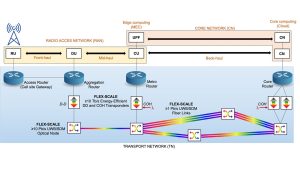The EU-funded Flexscale project is a pioneering optical network technology that enables unprecedented data speeds while dramatically reducing the energy consumption of the next generation of 6G telecommunications infrastructure.
As global data traffic continues to surge exponentially, communications networks face unprecedented challenges. While the continuous deployment of 5G has already pushed current infrastructure to its limits, the upcoming 6G ERA will demand more from our network, significantly improving energy efficiency as well as faster speeds.
Enter FlexScale, an ambitious EU-funded project addressing these challenges through groundbreaking research on optical network technologies. The project, which began in January 2023 and runs until December 2025, represents an investment of 8 million euros into the future of Europe’s communications under the EU’s Horizon-SNS-JU-2022 programme.
Professor Ioannis Tomkos, project coordinator for Flexscale at the University of Patras in Greece, explained: node. ”
Promote innovation through advanced photonics
The centre of flexscale innovation lies in the pioneering use of ultra-high-bandwidth photonic and plasmonic technologies, combined with the efficient exploitation of optical space and spectral switching.
These advanced technologies allow for the transmission and routing of information using optical signals over optical fibers, but with unprecedented capacity and energy efficiency. The aim of this project is to achieve record-breaking energy consumption of more than 1 picojoule per bit, which is about 100 times more efficient than current technology.
Tomkos said: “Today’s networks consume huge amounts of energy in electronic processing systems. Our approach replaces and bypasses these power-hungry systems with photonic integration and optical transparency, dramatically reducing both energy consumption and costs.”
The focus on energy efficiency and sustainability is particularly important as the telecommunications industry works to reduce its environmental footprint. By 2030, the ICT sector is estimated to account for up to 20% of global electricity consumption without significantly improving efficiency.
Creating a next-generation network architecture
Flexscale rethinks the entire architecture of communications networks to not only develop individual components but also support the requirements of 6G applications.
A major innovation is the multi-grain optical node (mg-on) that multiplex both the spectrum and spatial lanes of the multigrain band. This new node incorporates a Wave Band Selection Switch (WBSS) that can process huge amounts of data with unprecedented spectral flexibility and large-scale optical switching radix.

The project develops sophisticated and energy efficient networks by creating plasmonic-based optical digital to analog converters (ODACs). These innovative components help replace cost- and power-consuming electronic processing systems with more efficient optical replacements with simplified binary-powered electronics.
Pan-European Collaboration
The Flex Scale Consortium is made up of leading industrial technology and renowned scholars from institutions across Europe. The team includes experts in transformation transceivers, optical switches, network planning, operational algorithms, and protocol development.
Tomkos proudly states: “Our consortium spans the entire value chain. From basic research to commercial applications, we have the expertise needed to fulfill our commitment at 6G X-Haul and expand our European leadership.”
The project is based on the strong European leadership tradition in optical communications, aiming to strengthen the continent’s position in this strategically important area as global competition intensifies.
Heading towards the future of 6G
Once the project reaches a midpoint, the flexscale has already achieved a significant milestone. Recent testing has demonstrated a transmission system that operates at 140 GBD across the SCL band enabled by an ultra-high bandwidth plasmonic platform.
In a recent presentation at ECOC 2024 in Frankfurt, the team showed off their progress and engaged with leaders in other industry. The project has a final demonstration planned for the second half of 2025 and continues to move towards its ambitious goals.
The innovation developed by Flexscale could potentially appear in commercial communications infrastructure by the end of the decade as 6G deployments begin to increase. The technology in this project promises to be a game changer for the industry, enabling a new generation of applications that require extremely high bandwidth, ultra-low latency and unprecedented reliability.
Tomkos concludes: “Flexscale is about not only building faster networks, but creating a sustainable, energy-efficient foundation that will strengthen our digital society for decades to come.”
For carriers, equipment manufacturers, and ultimately everyday users, the benefits become transformative. We approach a world where digital experiences are seamlessly integrated into all aspects of our lives, significantly reducing the impact on the environment of an increasingly connected world.
This article will also be featured in the 23rd edition of Quarterly Publication.
Source link

